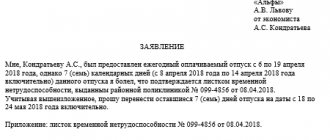Home / Labor Law / Responsibility / Material
Back
Published: 05/14/2016
Reading time: 9 min
0
5527
Current Russian legislation provides for mandatory compensation for damage caused to the employer.
The procedure for compensation depends on the type of legal relationship between them.
Let's take a closer look.
- How is the amount of damage caused determined?
- The procedure for an employer to recover compensation for damage caused
- Options for compensation for material damage by an employee Voluntary
- Extrajudicial
- Judicial
- Determining the deadline for going to court
- Example 1
How to deduct from salary by employer's decision
Deductions from an employee's salary occur for various reasons and are regulated by labor legislation. There are two types of financial liability for an employee : limited and full . The main detail when withholding is the moment of taxation of income. The first step is to calculate and withhold personal income tax and only later other penalties.
The employer has the right to legally deduct from wages:
- Overpayment of advance received towards salary;
- Unspent funds for company needs or business trips;
- Overpayment due to an error in accounting calculations;
- Other amounts, Part 2, Art. 137 Labor Code of the Russian Federation.
Important! An employee in accordance with Art. 136 of the Labor Code of the Russian Federation must be notified in writing of all cases of deduction from wages.
Law “On Enforcement Proceedings”
Article 100. Foreclosure of wages, pensions or other income of a debtor-citizen serving a sentence. Collection under executive documents is applied to the wages of citizens sentenced to correctional labor, minus deductions made by verdict or court order. Collection under executive documents is applied to wages, pensions or other income of citizens serving sentences in correctional institutions, including medical correctional institutions, medical and preventive institutions, as well as in pre-trial detention centers when they perform the functions of correctional institutions in relation to these citizens. Criminal Executive Code of the Russian Federation. Article 44. The procedure for making deductions from the wages of those sentenced to correctional labor. Penal inspections exercise control over the correctness and timeliness of deductions from the wages of those sentenced to correctional labor and the transfer of withheld amounts to the appropriate budget. To carry out such control, penal inspections have the right to involve financial and tax authorities. Deductions are made from wages at the main place of work of the convicted person for each month worked when paying wages, regardless of whether there are claims against him under enforcement documents. When making deductions, the monetary and in-kind portions of the convicted person’s wages are taken into account. The withheld amounts are transferred to the appropriate budget on a monthly basis. Deductions are not made from benefits received by a convicted person in the order of social insurance and social security, from lump-sum payments, with the exception of monthly insurance payments for compulsory social insurance against industrial accidents and occupational diseases.
The employee voluntarily pays the damages
The case when the financially responsible person agrees with the amount of damage to the company and is ready to compensate for it is quite simple. If a loss/shortage is identified during the inventory, the employee must familiarize himself with the report and the results of the audit.
The employer’s obligation is to obtain written consent, where the employee indicates that he is ready to voluntarily reimburse the entire amount of the loss or part of it (depending on the agreement with the company’s management) and indicate the source of payments.
If the amount of damage is greater than the average salary, a payment schedule should be developed, as well as a method of compensation in case the employee decides to quit. Otherwise, it will be possible to collect the debt from the citizen only through the court. Money to pay off the damage is deposited into the cash desk or into the company's bank account.
Important! Please pay attention to the fact that no more than 20% can be withheld from the salary of a financially responsible employee in all cases provided for by labor law, in other situations up to a maximum of 50%.
Find out more about the rules for deducting from your salary by following the link.
Individual cases Bank loan.
If there is a court decision that has entered into force, and the employer has been presented with a writ of execution for forced compensation of the employee’s debt under the loan agreement, then the amount of withholding cannot be more than 20%, or 50% if withheld on several documents - 2nd paragraph. 138th Art. (read more about how to withhold alimony or other debts under a writ of execution when paying for labor, here). And if the deduction is made on the basis of the employee’s application, from the period and in the amount specified therein, then it is possible to withhold the entire amount, of course, minus mandatory payments. But neither a bank, nor another counterparty, nor an employer can force someone to do this involuntarily.
Financial liability: consequences of shortage
On a general basis, limited financial liability in relation to an employee is ensured by the average monthly income. In a separate case, the employee is assigned full financial responsibility in the following cases:
- Provided by law;
- Causing damage as part of work duties;
- Harm in a state of various types of intoxication (alcohol, drugs);
- If confidential information was disclosed;
- Causing intentional harm;
- If provided for by job responsibilities (manager, cashier, chief accountant).
A complete list of specialties that require drawing up and signing an agreement on full financial liability with an employee is contained in Resolution of the Ministry of Labor of the Russian Federation dated December 31, 2002 No. 85. This type of agreement can be concluded with an employee who is over 18 years old.
Compensation for damage: reflection in accounting
It is generally established that the employer must prove the existence of loss/damage. The following activities will help identify deficiencies:
- Determine the amount of damage for the enterprise as a whole (in case of damage, negligence, theft, negligence);
- Identify the details of the incident, as well as the guilty employees.
The full amount of damage in monetary terms is established for the assessment of inventory items and other property at market prices at the time of the event, but not less than the actual cost in accounting.
The collection of evidence of the incident is carried out by an appointed inventory commission. An act is drawn up, and memos with explanations are taken from each employee. Deductions are carried out by order issued by management no later than one month from the date of discovery of the damage.
Calculations of this kind are accumulated on account 94, which is intended to summarize information about the amounts of shortages and other losses from damage to inventory items. Accounting entries in the case where the culprit is identified and deductions occur under limited liability :
Dt 73 Kt 94 - the amount of average monthly earnings
Dt 70 Kt 73 – the amount of the loss is written off from the salary.
Dt 50/51 Kt 73 – for the amount of damage (the employee contributes the funds voluntarily).
If the employee’s guilt could not be proven or the court proceedings did not satisfy the employer’s claim, then the following entry must be made in the accounting records:
Dt 91 Kt 94 - for the amount of damage that was included in other expenses.
Types of deductions
All deductions can be grouped into mandatory by law, optional at the initiative of the employer, or voluntary at the request of the employee.
The first group of withholdings is mandatory - withholding 13% of the personal income tax, the amounts specified in the court decision, writ of execution or order of the bailiff.
The employee’s consent or the employer’s permission is not required to produce them.
The second group of deductions - at the initiative of the employer - can be in 6 cases.
1. The employee received an advance, but did not work the allotted time and quit . Some employers pay a fixed advance - 50% of the salary. They take into account the actual number of shifts worked only when calculating at the end of the month. If an employee worked few shifts, received an advance and immediately quit, he received too much.
The employer can withhold the money during the final payment or reclassify it as compensation for unused vacation.
2. The employee received advance travel allowances, but did not spend them all and did not return them upon returning from the business trip . For example, Ivanov was given 10,000 rubles in advance to cover the cost of paying for a hotel room. But Ivanov finished his business earlier, returned home, and from 10,000 rubles he still had 1,500 rubles unspent.
The employer can withhold 1,500 rubles from the next salary.
3. A counting error has occurred . This is a very controversial basis, since the law does not define the concept of “counting error”. There is an opinion from Rostrud that the counting error is an arithmetic one.
Whether a technical error is considered a counting error is also unclear - the law does not say anything, the courts say different things (see the ruling of the Sverdlovsk Regional Court dated 04/21/2016 in case No. 33-7642/2016, the Samara Regional Court ruling dated 01/18/2012 No. 33-302/ 2012).
In any case, the law has such a basis, which means the employer has the right to use it to withhold, for example, overpaid wages.
4. The employee did not fulfill the work standard through his own fault, and the labor dispute commission or court confirmed this . For example, an employee must produce 50 products a week, for which he is paid 5,000 rubles. For unknown reasons, he produced only 40 items.
The employer organized a commission on labor disputes, at the meeting they recorded the fact of shortcomings, and the manager had the right to withhold wages from the employee on account of unmanufactured products.
5. The employee took 28 days off, but did not work for a full year . For example, Ivanov got a job in March, worked for six months and went on full leave. After his vacation, Ivanov worked for another 2 months and quit. He received 4 months of vacation pay in excess, so the employer can withhold this money when calculating.
6. The employee caused material damage to the employer . For example, an employee spilled coffee on the keyboard and it stopped working. He caused damage to the employer, so the latter can deduct wages.
The third group of deductions is at the request of the employee. For example, an employee asked an accountant to send part of his salary to the bank to pay off a loan. The Ministry of Labor believes that this cannot be done: the law allows deductions only in certain cases, and this is not on the list.
General example of registration for compensation of damage
Example : During the inventory process, a shortage of inventory items of 15,000 rubles was discovered. After collecting written statements and conducting interviews, the guilty employee was identified. The order established that damages are recovered from the salary of the financially responsible employee. His salary is 35,000 rubles per month.
| Composition of the operation | Amount, rub | Turnover Dt | Revolutions Kt |
| Employee salary accrued | 35 000 | 20,26,44 | 70 |
| Personal income tax withheld 13% | 4 550 | 70 | 68-1 |
| The amount of retained loss is determined: (35,000-4,550) x 20% | 6 090 | 70 | 73 |
| The amount to be paid is calculated: 35,000 – 4,550 – 6,090 | 24 360 | 70 | 50/51 |
Benefits for temporary disability of a convicted person
Calculated from his salary without taking into account deductions in the amount established by the court verdict. In cases of cancellation or change of a court verdict with the termination of the case, the amounts excessively withheld from the wages of the convicted person are returned to him in full. The criminal-executive inspection, the convicted person himself or the administration of the organization in which he works, has the right to apply to the court with a petition to reduce the amount of deductions from the convicted person’s salary in the event of a deterioration in his financial situation. The decision to reduce the amount of deductions is made taking into account all the income of the convicted person. Part 3, 107th Art. The PEC establishes, in part, rules that are even more humane than general ones: at least 25% of the salary is credited to the personal account of convicted persons; for the elderly, minors and women with small children - at least 50% of the accrued salary.
When it is impossible to withhold damage from an employee’s salary
It should be noted that there are circumstances when the employee is not to blame and financial liability does not arise. This:
- Failure by the employer to provide conditions for secure storage of valuables;
- Force majeure (force majeure circumstances);
- Reasonable business risk;
- Other situations mentioned in Article 239 of the Labor Code of the Russian Federation.
In conclusion, it remains to add that in order to accurately process a loss compensation operation, the accountant will need to comply with the rules:
- Documents confirm the existence of shortages or material damage;
- Establish full or limited liability of the employee;
- Comply with the 20% limit on salary deductions;
- Carry out actions to ensure that employees are able to accurately perform their job functions.
Rate the quality of the article. Your opinion is important to us:
Maximum and minimum amounts
The topic “maximum and minimum deductions from wages” needs to be divided separately for voluntary and mandatory deductions.
As Rostrud points out, in letter PR/7156-6-1 (see text above), the restrictions of Art. 138 . do not apply to withdrawals made at the request of the employee, within the time frame and amount specified by him. Thus, the worker independently and of his own free will manages his funds and determines what is the maximum amount for him and what is the minimum. He can dispose of part of the salary or ask to withhold it entirely for selected needs: payment of utilities, transfer to third parties, pay under contracts.
Article 138 of the Labor Code “Limitation on the amount of deductions from wages” relates to mandatory deductions made according to executive documents and based on Article 137. TC orders of the employer and will help calculate the percentage of the amount of deduction. Here we can mention, in addition to the 138th, also the 99th Art. Law on Enforcement Proceedings, containing similar provisions.
138th Art. The TC contains the following size restrictions:
- their total size cannot exceed 20%;
- in cases established by laws (On Enforcement Proceedings, Criminal Executive Code) – 50%;
- for exceptional cases, a general limit of 70% - these are deductions for correctional labor, alimony, compensation for harm to health, the death of a breadwinner, or from a crime committed.
At the same time, the PEC limits the amount of deductions from wages for the least protected persons serving sentences: the disabled, the elderly, women with children.








